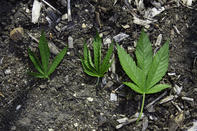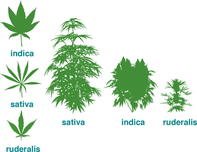In his book, Psychedelics Encyclopedia, Peter Stafford states that most experts agree that there are at least three species of Cannabis plants which differ from each other in growth habit, seeds, stalk and resin (cannabinoid) content.

Species of Hemp and Cannabis
Cannabis sativa L. is a subspecies of cannabis known as hemp. Varieties have a THC content of less than 0.3%. Hemp is a non-psychoactive form of cannabis. The species was discovered in China and classified in 1753 as Cannabis sativa Linnaeus, named after Carl Linnaeus, a Swedish botanist. This species produces strong fibres, can grow up to 5m tall and is very suitable for hemp seed and fibre production.
Cannabis indica Lamarck is a short bushier plant with a conical growth habit and is not suitable for fibre production. Cannabis indica or marijuana has the highest level of the psychoactive resin tetrahydrocannabinol (THC) with THC concentrations of 18% to 38%.
A third species, Cannabis ruderalis was identified in 1924 in Siberia where it grows wild. This species, which grows just over 60 cm tall, has little psychoactivity and matures within 7 weeks. Seeds of C. ruderalis were used in funeral rites from before 450 B.C.
The C. sativa-type was first to spread to the rest of the world, probably due to its useful fibres and edible seeds.

Types of Hemp
University of Kentucky’s College of Agriculture, Food and Environment Cooperative Extension Service advises hemp farmers to research hemp varieties based on the component of the hemp plant they aim to harvest. Components can be fibre for textiles and building materials, hemp seeds for oil production or the vegetative parts for CBD oil production. They need to choose varieties that are proven performers for these applications.
The long primary hemp fibres on the outside of the hemp stalk are used for composites, reinforcements, textiles, pulp and paper. These strong outer fibres are bound to the inner stalk with pectin, a soluble carbohydrate.
The wood-like core of the hemp stalk (hurd) is used for building materials, biofuel, animal bedding and mulch. While hemp seeds yield high-protein oils and hemp protein flour. Flowers and leaves are used to extract the cannabinoid CBD-rich oil for medicinal and health applications.
Specific strains of industrial hemp are used for the production-specific end-products; hemp seed, fibre and dual-purpose which produces both fibre and seed. Hemp dual-purpose strains do not produce as much as or of the same quality of single-purpose hemp cultivars.
By Marinda Louw